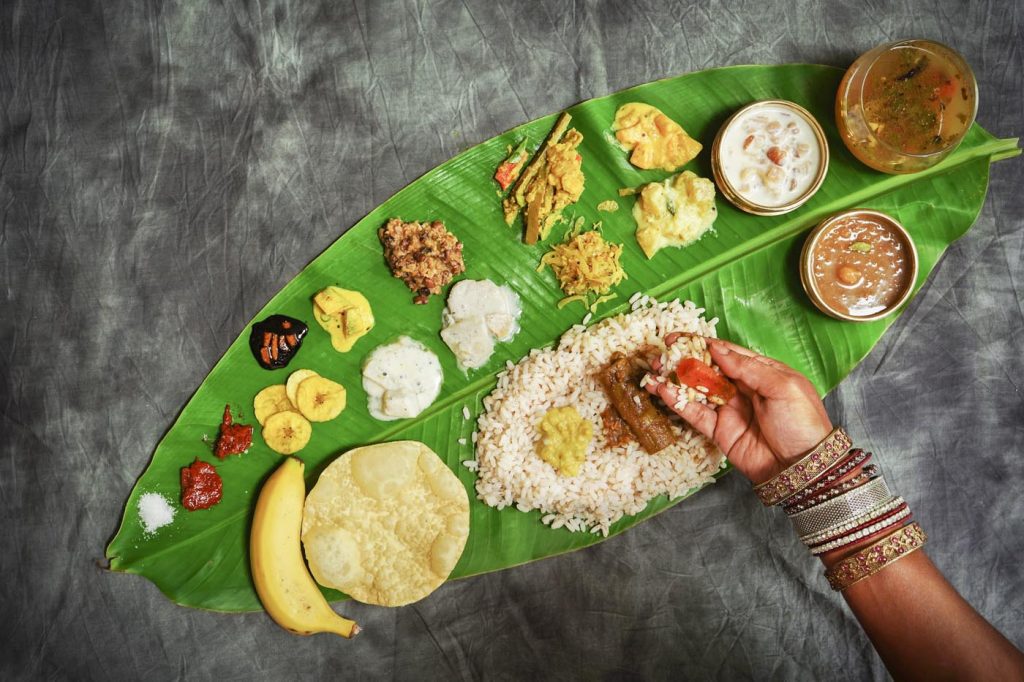By Devi Ravindraraj, Texas
What is beautiful, healthful, environmentally-friendly, fun to eat from, and a long-established feature of Hindu culture? Leaf plates! One of the joys of growing up Hindu in the diaspora is celebrating festivals from different regions of India, not just one. What we may not know is that each has its own practical, eco-conscious ways of serving festive foods. Learning about these bio-platters can open many doors, illuminating connections between our culture and the world around us. It can provide a window into botany, biochemistry, soils and other sciences. It can open our eyes to the lives and struggles of farmers and connect us to global social issues such as sustainability, Indigenous forest rights, waste management and climate change. Most of all, it empowers us with something we can do with our own hands.
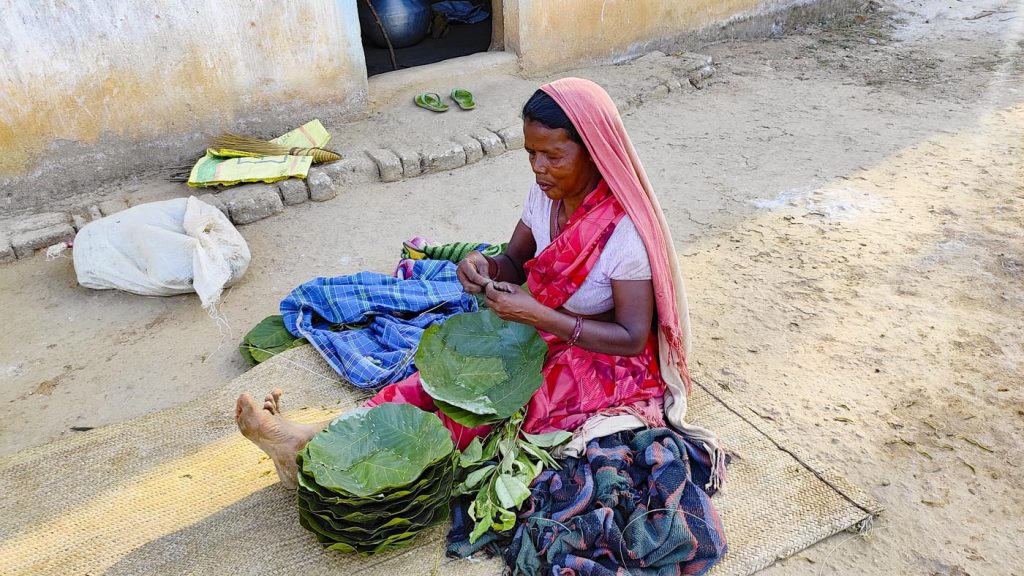

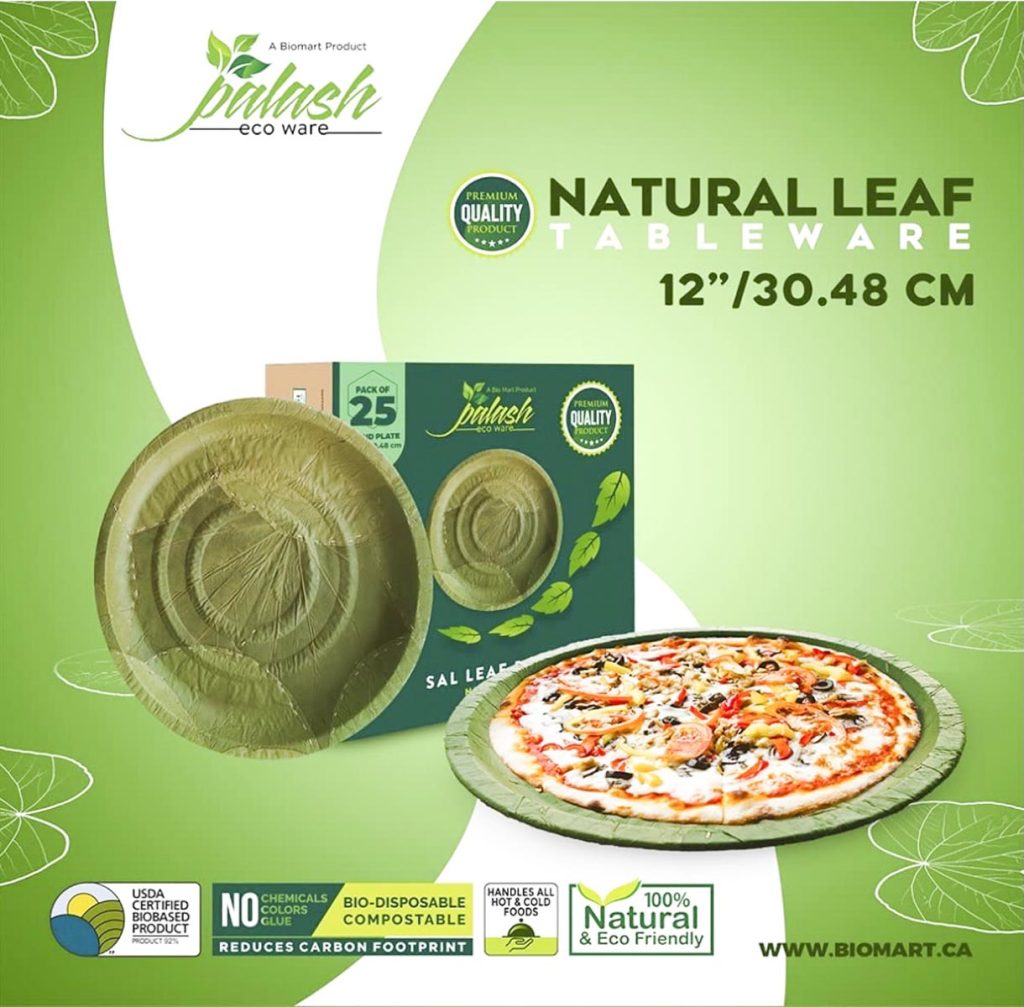
There are a multitude of ways to categorize leaf plates: fresh or dried, large or small, single or stitched. Many leaves can be used in various ways. Let us begin with the banana, one of several plants honored with the Sanskrit title kalpataru (“wish fulfilling”). Banana leaves are freshly picked, washed and used as a plate by themselves. Small leaves can be used whole; larger ones are cut into sections. Banana leaves are absolutely relished by cows and other animals, and compost easily.
Either pre-softened or used directly with piping hot food, banana leaves also make pliable, aromatic wraps to transport cooked meals. Such parcels can be tied with the dried ribbon made from the “trunk” of finished banana plants—the same strong, flexible fiber used to tie thick garlands. Larger strips of banana sheath can be machine-pressed into the shape of small cups.
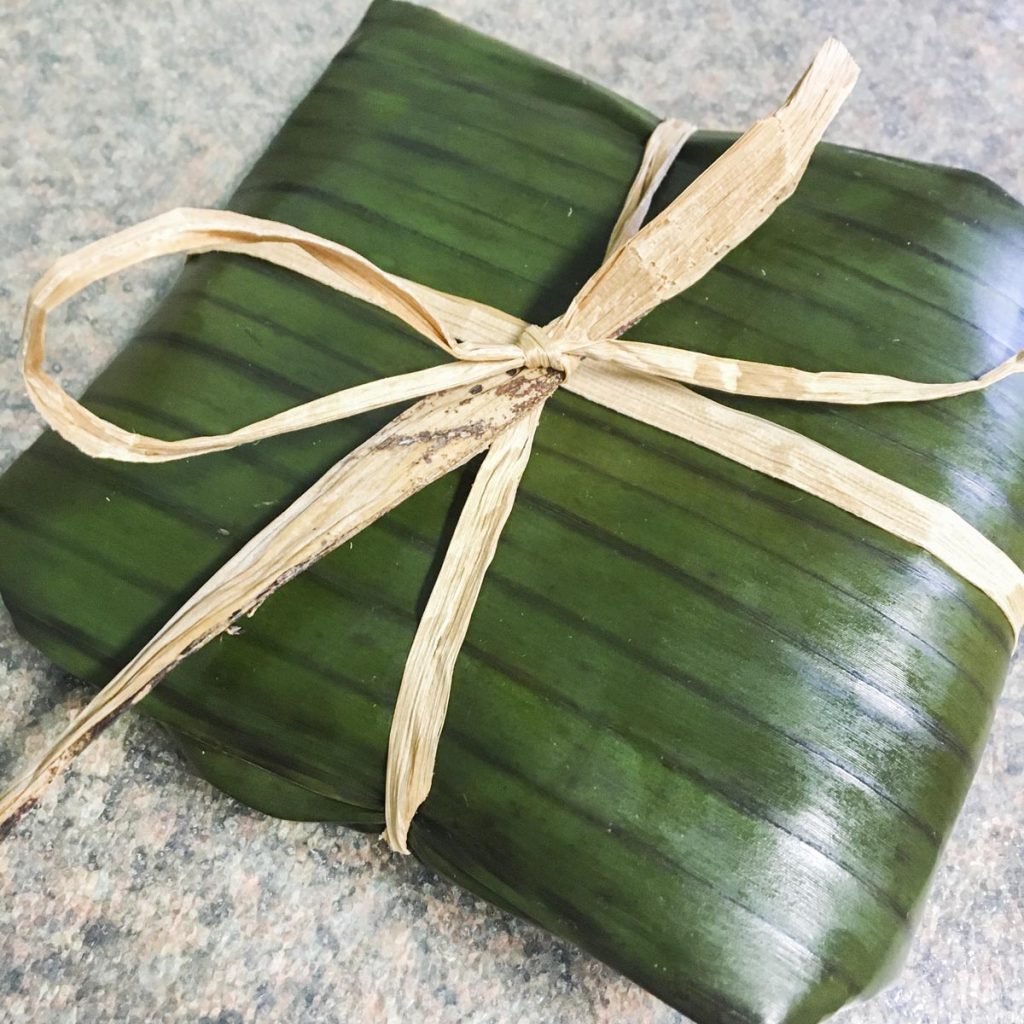
Other plates are made from multiple leaves stitched together. Many types of leaves are used in this way, and they come from plants as diverse as the climates of India. Sal leaves, from the towering Shorea robusta are very popular. Often found growing up the sal tree is the thick, woody vine Phanera vahlii. Valued for their size, shape and flavor, these vine leaves are known as taur in the Himalayas, siali in Odisha and mantharai in Tamil. Additional sources of leaves include (but are not limited to!) jackfruit, teak and several trees from the Ficus genus, including banyan, peepal and Ficus auriculata, which features particularly large leaves.
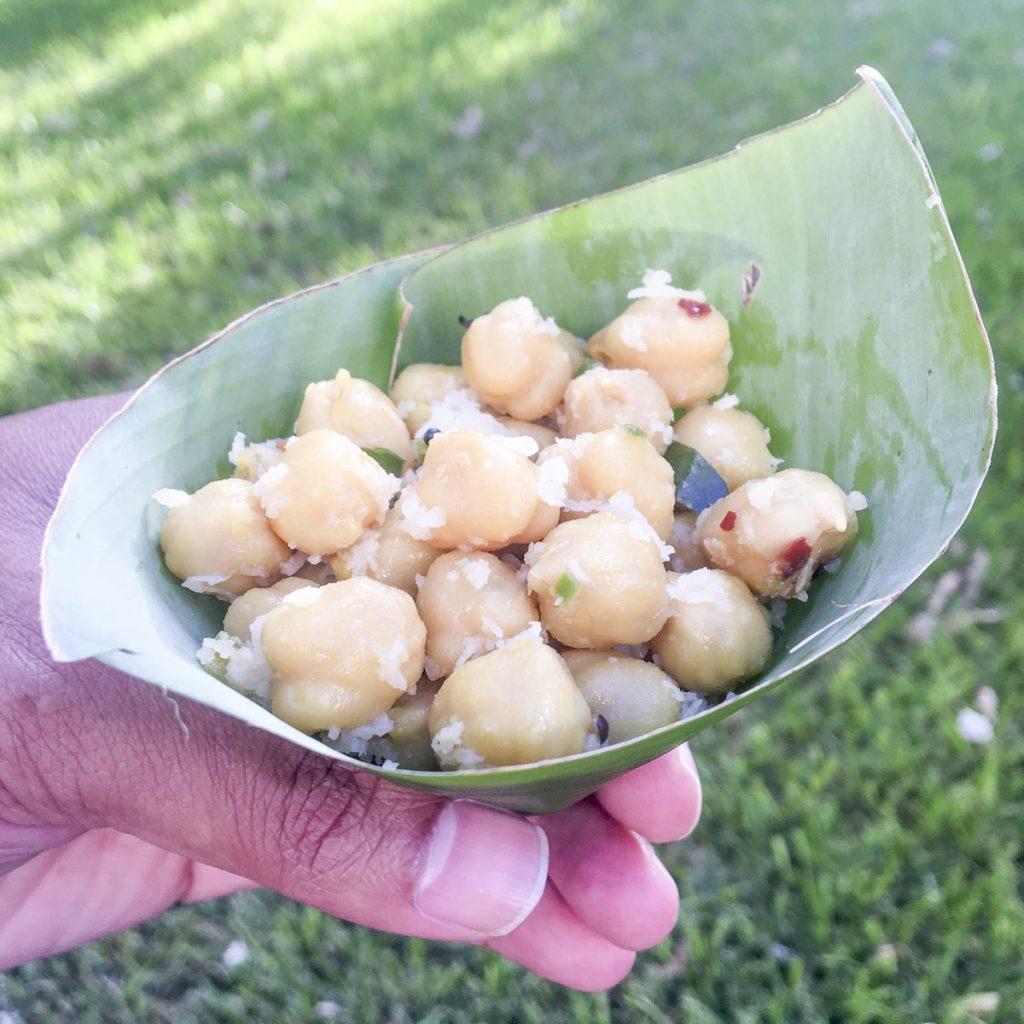
In addition to stitching together flat plates, the deft use of tiny sticks also quickly shapes leaves into cones, cups and bowls. In Nepal, patravali are referred to as a trifecta: tapari (slightly curved large plate), duna (medium-sized bowl) and bota (the smallest). Throughout the subcontinent, stitched leaf plates and bowls may also be shaped with the help of a hydraulic press, which makes them easy to store and transport. The same type of press is used to transform fallen areca palm sheaths into the uniform party dining ware now popular for the export market.
While, roughly speaking, banana leaves for dining are more famous in South India and Sri Lanka, and stitched leaf plates more so in North India and Nepal, there are many areas of overlap. Northeast India is extremely rich not only in cultural uses of banana leaves to craft delightful plates and bowls but also in banana biodiversity. Arunachal Pradesh alone has 11 species of native wild bananas. In Odisha, the mahaprasadams of Lingaraja and Ananata Vasudeva temples in Bhubaneswar are served on banana leaves; in Maharashtra, a delicious thali has its own rules for arrangement on a fresh banana leaf, oriented upwards. In the South, dried leaf plates of sal, maloo creeper and other leaves are especially popular for smaller snack items.
Tamil Nadu’s famous Chidambaram Temple uses dried-leaf donai to serve sweet rice, curd rice and sundal. In Trichy, children who participate in singing Tiruvembavai while circumabulating Uchi Malai Kovil early every morning during Margazhi gleefully receive a leaf donai filled with breakfast prasadam before heading to school. In Bihar, for a great example of a meal served using multiple types of traditional leaf plates, both fresh-cut and dried/stitched, watch Anubhav Sapra’s visit to Darbhanga for a Mithila feast (youtu.be/FFpaivx04R8?t=1937). Another example of convergence, in Mauritius, occurs where the banana leaf is de rigueur for traditional feasts among Hindus of all regional backgrounds.
From Kerala’s Onam sadya and the vazhai ilai sappad of Tamil Nadu, to the rich regional dhams of Himachal Pradesh, India has no shortage of feasts that would be incomplete if not served on their iconic leaf bases.
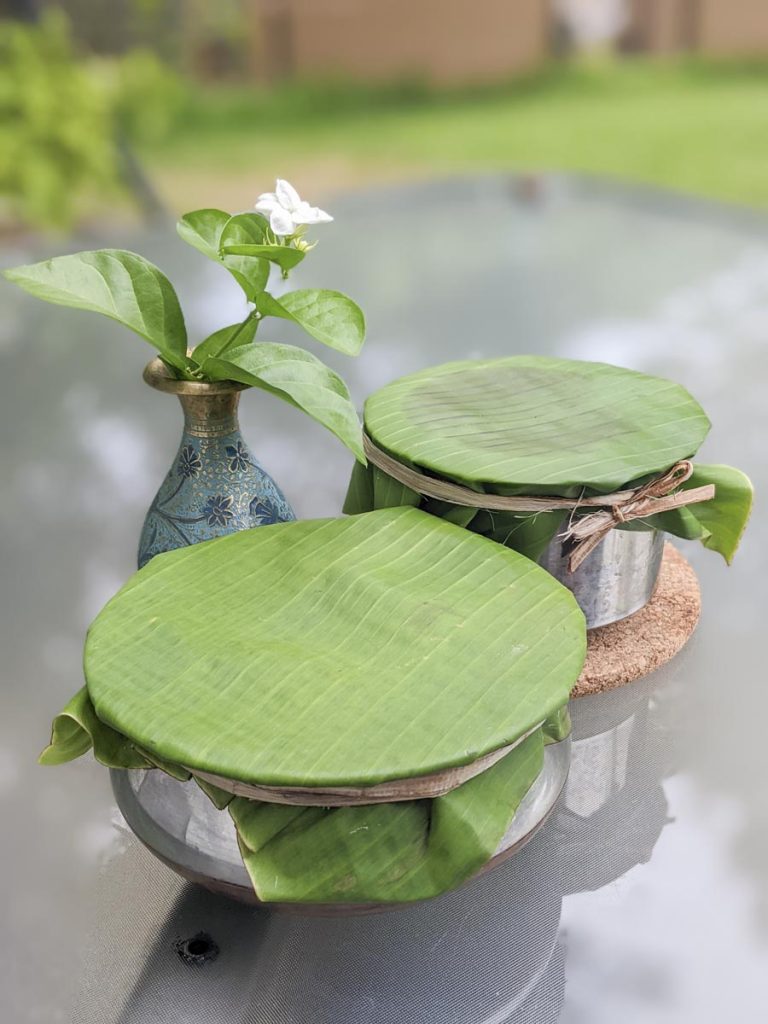
Small bites, however, have just as big of a role to play in environmentally friendly eating. A street-side samosa just tastes better when you know that its leafy plate will quickly biodegrade and, unlike a plastic one, can even be a tasty treat for an animal friend. Even those delicacies whose leaf is primarily known for the flavor and structure it imparts during cooking (such as with kumbilappam, turmeric-leaf patholi or leaf-basket idlis) can be eaten by hand with a minimum of waste thanks to their built-in wrapper.
One leaf we have not yet mentioned is that of the lotus, India’s national flower and Hinduism’s most sacred plant. A traditional but lesser-known alternative to the banana leaf, lotus leaves are also large enough to hold an entire meal. Throughout the Indian subcontinent, lotus leaves are used interchangeably with other types of leaf plates. For example, in a delightfully detailed caption to one of her paintings shared on Instagram, acclaimed artist Upasana Govindarajan describes childhood picnics with her grandmother, including how a neighbor would fetch lotus leaves from a nearby pond if they had not packed banana leaves.
Leaf Plates in the Diaspora
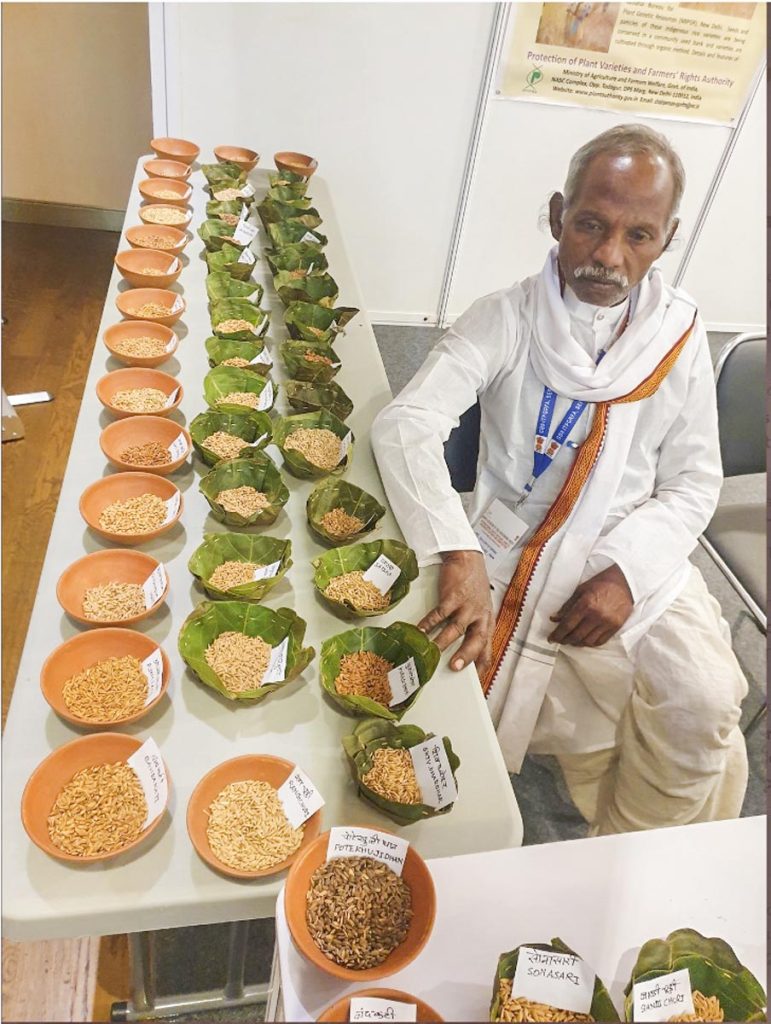
While in India the use of lotus leaves is drifting towards the nebulous realm of nostalgia, in Guyana vegetarian food served in a lotus leaf is such a national point of pride that the government has included a “Seven Curry Tour,” including harvesting the lotus leaf, among three initiatives recently launched by the Guyana Tourism Authority. And anyone who dares tag a photo of an otherwise authentic-looking meal (but served on a polystyrene plate) as “Seven Curry” will be met with a chorus of replies asking where the lotus leaf is.
In Trinidad, the sohari plant (Calathea lutea), indigenous to the area, has long assumed a place of pride alongside banana leaves for serving delicious “prayers food,” as the vegetarian meal accompanying any puja is fondly called in the Caribbean. It may be that the wild-growing sohari was originally adopted by indentured laborers because of restricted access to the leaves of the banana plant, which were the property of the British plantation owners. However, this alternate leaf has now grown into a beloved part of Indo-Trinidadian culture.
Will Leaf Plates Be Left Behind?
Despite this rich and varied history, and bright spots of adaptation and resilience, Hindu leaf plate traditions are at risk. The first risk is the sheer size of influence from Western disposable products. Ruchita Kumari, in her late twenties, says that natural leaf plates are still available in cities such as Patna if you ask for them but their prevalence has been drastically reduced, especially in the last fifteen years. She is clear about the cause of this shift—clever marketing. Plastic products, she says, have been promoted as “equally as good, and even better quality” than the traditional Indian materials, “but they don’t go back to the earth. There are consequences for your health. All of these negatives have been neglected in the marketing campaigns for plastic. But once they enter the market, they replace all other products.” Despite mounting hazards to our oceans, rivers, mountains and entire planet’s health, global single-use plastic production is only gaining speed, not slowing down.
Recognizing the gravity of the problem and building upon state and citywide initiatives, India passed one of the world’s most ambitious plastics bans in 2022. Such actions can potentially help the farmers, gatherers and artisans who produce traditional leaf plates. As Baldev Kumar, a leaf plate maker from Himachal Pradesh, told the The Tribune after that state’s plastic ban in 2018: “We have heaved a sigh of relief as we can continue with our traditional profession, which was on the edge because of machine-made plastic plates.” However, serious questions about the national ban remain.
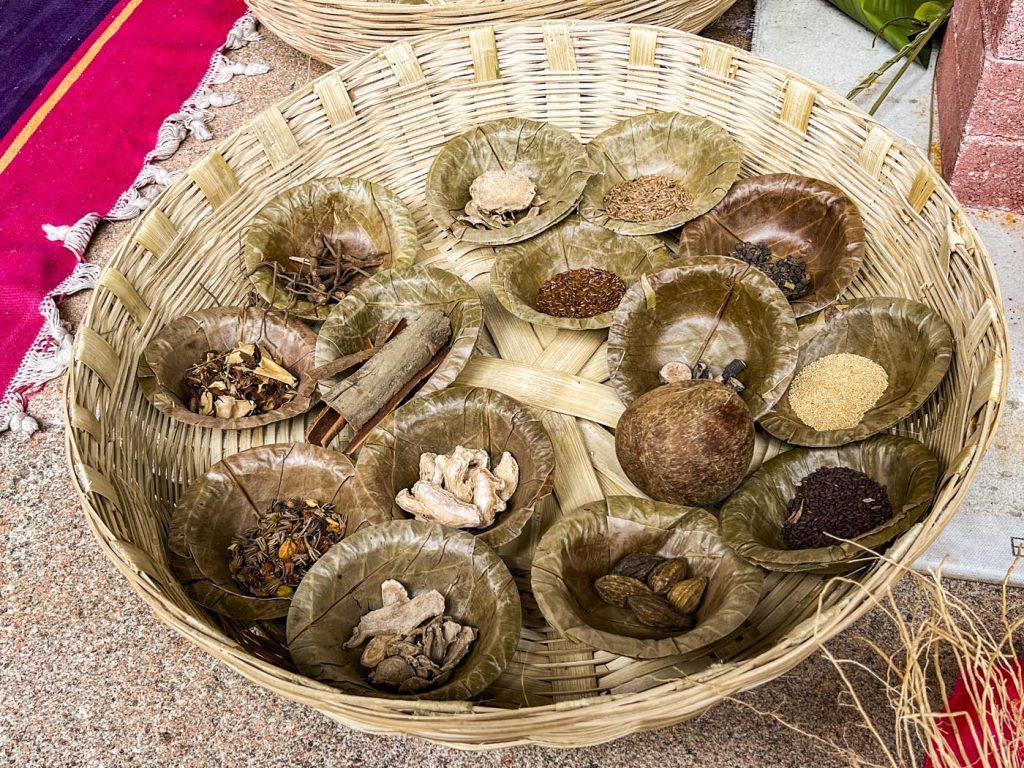
The second risk is assuming that no matter how long we wait, eco-friendly traditions such as leaf plates will be waiting for us, somewhere, should we ever wish to return to them. Like the Svalbard Global Seed Vault for Earth’s crops, are there protected enclaves for biocultural diversity such as our leaf-plate traditions? The answer is complex, and worrisome. As Dr. Tara Devi Sen succinctly says of taur and tremal plates on her site Himalayan Wild Food Plants, “These traditional practices are in sharp decline due to easy availability of plastic plates. The need of the hour is to promote and revive these eco-friendly social practices.” Lotus and all other leaf traditions have been similarly eroding.
While banana-leaf feasts for weddings are still popular in many places, use of the leaves in diverse and everyday ways is waning. Meal parcels wrapped in a banana leaf can no longer be found for purchase on Indian rail journeys, whereas they were readily available up to the late 1990s. Food bloggers today attest to this timeline, prefacing special recipes with nostalgic praise for the banana leaf packets they relished on childhood train journeys. Reading these stories of nutritious, eco-friendly food packed by parents and grandparents is pleasant and mouth watering until the thought strikes: who will have these memories three, two—or even one—generation from now?
The same saga of the banana leaf has played out in Malaysia. Centrally located within the original homelands of the banana family, banana-leaf traditions survived and thrived in Malaysian Hindu communities. Yet, despite having a warm tropical climate that is only getting warmer, in Malaysia banana leaves have been edged out as the default plate-plus-packaging material in just 30 years, largely by polystyrene. Meanwhile, Australia grows all its own bananas but lacks a banana-leaf industry, despite the abundant availability of leaves.
Even in those diaspora areas where leaf plates are still popular, eco-friendly systems for disposing them such as composting may be minimally available. This is a concern because when any one part of the cultural ecosystem is lost, it becomes easier for other parts to become merely token, symbolic—and then replaced. In India, for example, the presses designed for leaf donai are now often used to make identically-shaped bowls using plastic scrap. And when banana-leaf feasts are held in the United States on special days in the Hindu year, the leaves are always sent straight to a landfill, rolled up in a paper or plastic sheet. In such ways, the usefulness of the original practices is entirely lost, both literally and educationally.
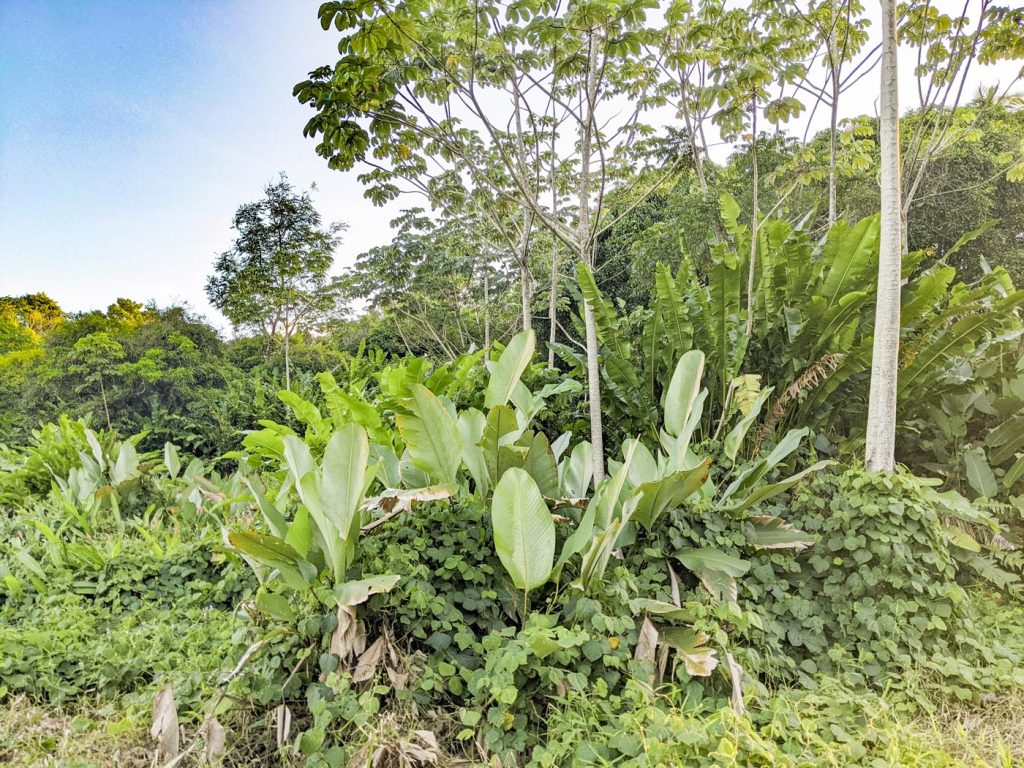
Even in those diaspora areas where leaf plates are still popular, eco-friendly systems for disposing them such as composting may be minimally available. This is a concern because when any one part of the cultural ecosystem is lost, it becomes easier for other parts to become merely token, symbolic—and then replaced. In India, for example, the presses designed for leaf donai are now often used to make identically-shaped bowls using plastic scrap. And when banana-leaf feasts are held in the United States on special days in the Hindu year, the leaves are always sent straight to a landfill, rolled up in a paper or plastic sheet. In such ways, the usefulness of the original practices is entirely lost, both literally and educationally.
A third risk is that Hindu youth may not even identify eco-friendly traditions such as leaf plates as being part of our culture. This last risk highlights another, different fate that could easily await Hindu leaf-plate traditions around the corner: appropriated and transformed into a trendy, commercial product by and for the West, readily available for sale in stores but no longer found in temples. Such an outcome, with leaf-plate traditions bereft of their cultural and ecological moorings, would be a loss to everyone.
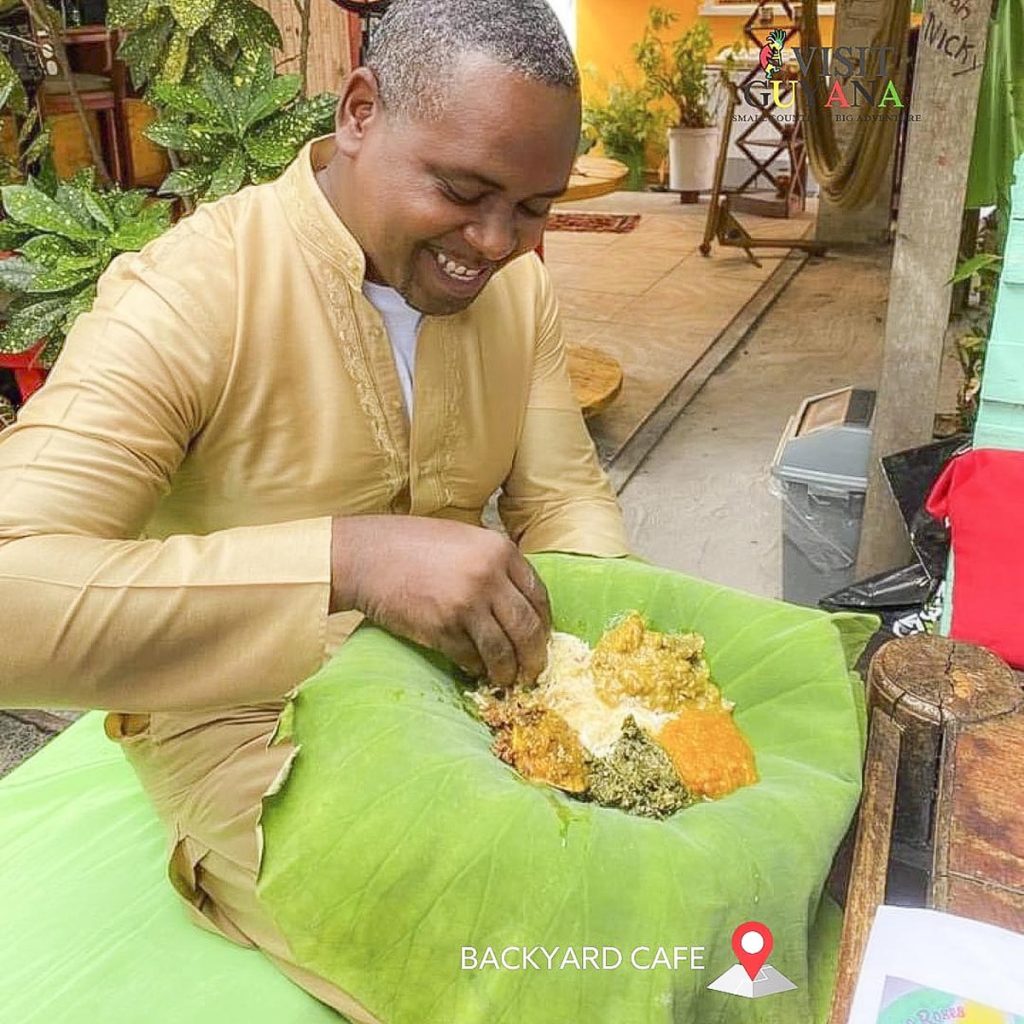
Turning Over a New Leaf
In this dire situation, one may wonder how we can support leaf-plate traditions if we are living far away from India, or even in any highly urbanized area. Surely, the necessary leaves will not be readily available? There are many ways to answer this question. The first is simply to realize that plastic products such as polystyrene are not “locally available” anywhere.
All have to be extracted from deep in the earth, refined via highly polluting processes, pressed into tiny pellets (the infamous “plastic snow” that blanketed Sri Lanka’s beaches after the X-Press Pearl container ship burned and sank in 2021), shipped to manufacturing plants to take the shape of various products and then finally transported back to distribution warehouses and stores from which we purchase them and further transport them to our homes, halls and temples.
This entire process entails much pollution and up to several trips around the globe—and that’s before the products enter the trash stream. Once we realize this, we can wake up to how these Western products became normalized and imagine what we may want the future to look like instead.
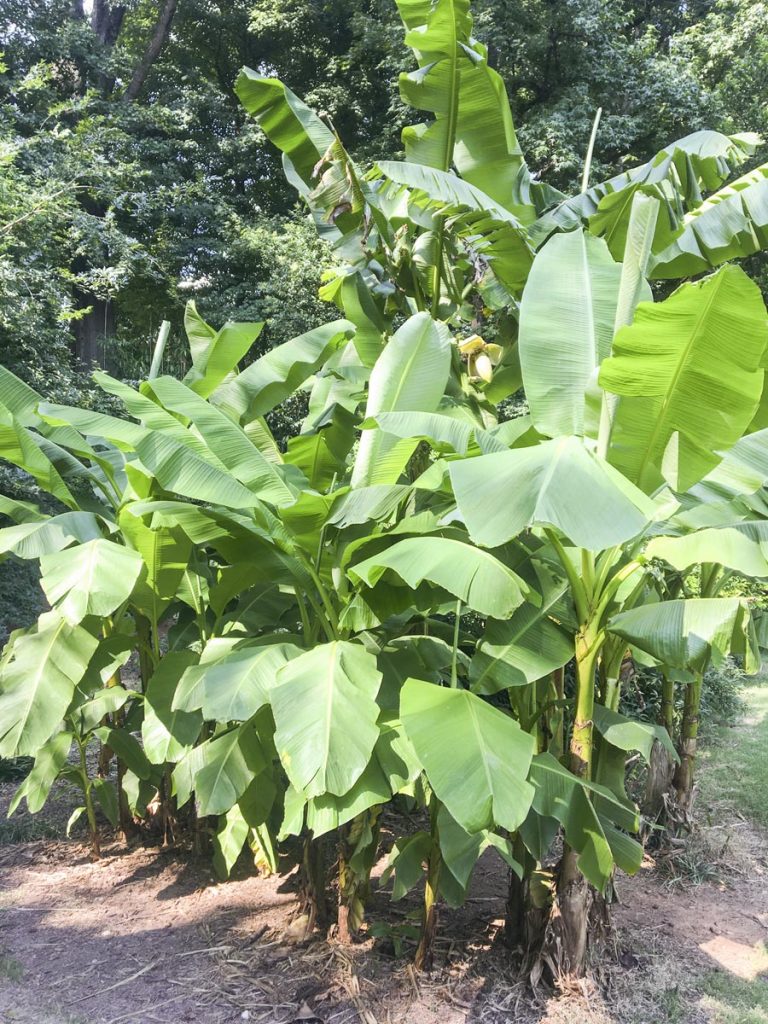
Fortunately, all of the perils discussed have solutions, if we start soon. While we live in an age of homogenization and mass extinction, many things have indeed been saved from this fate—languages, art forms and biological species—when alert individuals have woken up to the situation, organized others and acted decisively. Like other aspects of Hindu culture, leaf-plate traditions exist as part of an ecosystem—literally! To bring these traditions fully alive for young Hindus around the world, this ecosystem should be as vibrant and environmentally-meaningful as possible. Here are some ways that we can do that:
Compost: Sonal Agrawal, who grew up in a Rajasthani family in a small town, fondly remembers that all the vegetable scraps from her household’s kitchen would be collected in a bucket which she delighted in taking out to feed any of the neighborhood cows. She feels that getting involved in composting is the best opportunity to give youth in highly urbanized areas the same feeling. While there is nothing quite like the fun of feeding a banana leaf or a crunchy dried-leaf donai plate to an eager ruminant, composting is the most nature-friendly option that most of us living in urban areas have access to for our used leaf plates.
For whatever types of leaf plate we are working to revive, it is crucial that we make composting available, either by starting our own at home or in our temple community, or by accessing composting resources already available where we live.
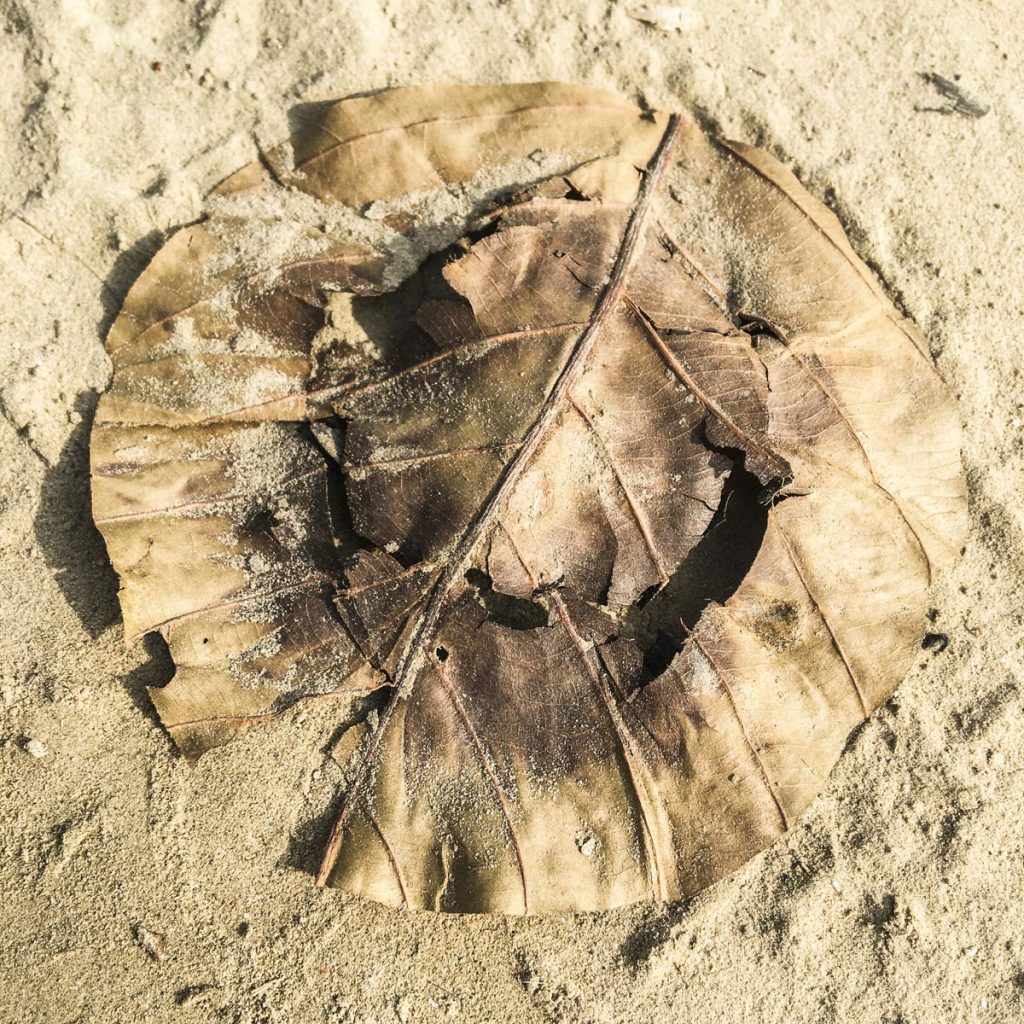
Leaf plates of all kinds are uniquely well-suited for composting, because there is no need to separate food waste (hopefully minimal!) from the eating surface—both go together into the compost. Even in reusable plate/bring-your-own systems, the use of a leaf as a liner facilitates easy composting, minimizes the washing required and maximizes sanitation.
Involve a youth corps: Involving temple youth in a program of serving with and composting leaf plates, and even growing some of the leaves in home and temple gardens, can go a long way in reinforcing Hinduism’s strong history of environmental values as well as the values of seva and annadanam. Leaf plate traditions also integrate seamlessly into existing Bal Vihar programs in a variety of ways. The names of plants used for leaf plates can even be featured in the temple’s language classes, with leaf coloring, tracing and cut-outs for little ones and research posters for older students.
Learn/listen: Visit elder relatives or artisans in India to observe the process of making stitched leaf plates. Take time to listen to their stories about demand for the plates, access to materials and other issues. Back home in our local environments, learn about commonalities with Indigenous communities where we live: what local plant materials make good food surfaces and strong, flexible ties? What obstacles do Indigenous people face in being able to access materials that their communities traditionally use?
Discover new leaves: Another way to honor the wisdom of our ancestors and follow in their footsteps is to carefully observe the plants around us and think creatively about how they can be used. It may be a native plant or one already widely introduced. Cocoloba uvifera (seagrape), for example, is native to the southeastern United States and the Caribbean but has been widely planted around the world for its salt tolerance and versatility. Its leaves are round, sturdy and smooth, keep well for many days without refrigeration and are the perfect size for serving snacks and temple prasadam.
When using banana leaves: In addition to purchasing banana leaves from wholesalers and grocers, grow some of the leaves locally and organically. Backyard growing reduces pesticide exposure and is highly educational. While bananas require many months of consistent temperatures to produce ripe fruit, the vegetative parts of the plant are fast-growing and thrive in a much wider range of climates. Bananas have more than 75 known species and hundreds of varieties and cultivars, all with excellent leaf properties. Some cultivars produce lush leaves while remaining extremely compact, resisting wind damage and fitting into an easy-to-carry pot. Mountain-growing species are highly cold-tolerant, reliably re-emerging every spring even in snowy climates. Modern edible fruit varieties are just the tip of the iceberg when it comes to sources of banana leaves.
In addition, explore the many faceted utility of the banana leaf. Did you know, for instance, that a banana leaf placed over a serving dish or pot of hot food, secured with a banana-fiber tie, molds even better than plastic wrap? To revive such eco-friendly traditions, we will have to become re-conversant in the capabilities and properties of various leaves so that we can quickly and efficiently use them.

Perhaps the most under-utilized connection yet between Hindu leaf-plate traditions and our new environments is North America’s own lotus, Nelumbo lutea, which grows abundantly in lakes as far north as Eastern Canada. The sole sister species to the sacred lotus of Asia (Nelumbo nucifera), the “American lotus” shares the same properties of luxurious, water-repellent leaves and edible tubers and seeds. While holding protected status as a native wildflower in some parts of the US, in other areas local departments actually destroy the lotus to create better fishing access for boats. These leaves could be harvested instead. It’s a shame to let this beautiful and useful plant go to waste.
Let’s find ways to adapt our traditions to benefit our local environments wherever we live and inspire our younger generations back in India, Sri Lanka and Nepal with pride.
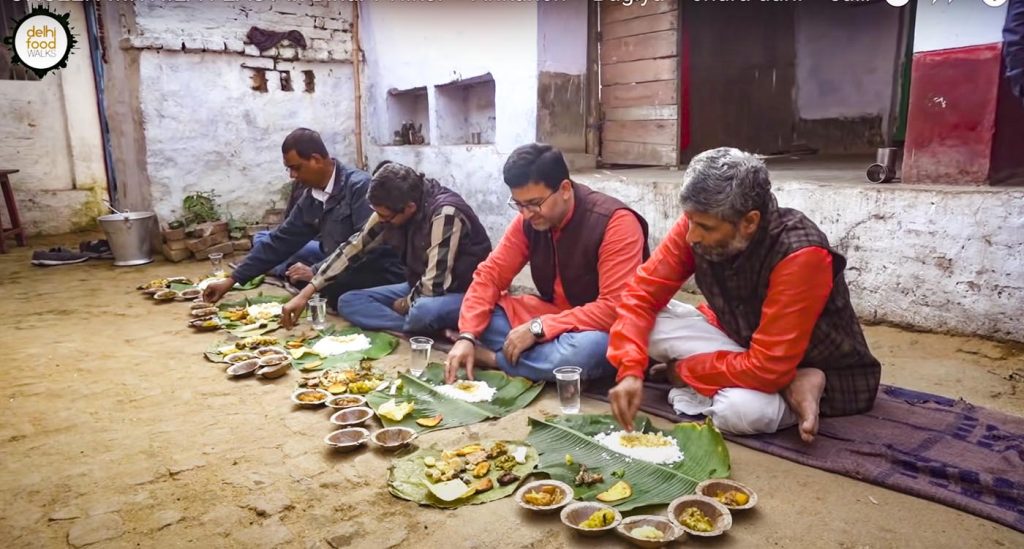
Learn more
Read: Kora, A.J. “Leaves as Dining Plates, Food Wraps and Food Packing Material: Importance of Renewable Resources in Indian Culture.” Bull Natl Res Cent 43, 205 (2019). https://doi.org/10.1186/s42269-019-0231-6
Watch: Ekta Chaudhary’s “Prepare Khaad/Compost from Kitchen Waste” is a nice introduction to composting, in Hindi with English subtitles, especially geared towards urban dwellers: youtu.be/daAh_evRn0Q.
Collaborate: https://forum.pradakshina.org. Volunteers share memories of leaf plate traditions from childhood, knowledge and strategies gleaned while working to reintroduce leaf plates at Hindu temples and youth programs outside of India, and gardening and composting expertise… all towards the common goal of keeping Hinduism’s leaf plate traditions healthy and vibrant around the world.
About the author
Mrs. Devi Ravindraraj is the Executive Director of Pradakshina, a nonprofit organization dedicated to supporting India and Sri Lanka’s leaf-plate traditions through diasporan youth engagement.
Contact: om@pradakshina.org
